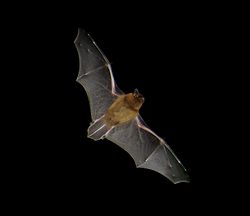Common pipistrelle
The common pipistrelle (Pipistrellus pipistrellus) is a small bat with a very large range across most of Europe, North Africa, southwestern Asia, and possibly into Korea. It is one of the most common bat species in the British Isles.
| Common pipistrelle | |
|---|---|

| |
| Conservation status | |
| Scientific classification | |
| Kingdom: | |
| Class: | |
| Order: | |
| Suborder: | |
| Family: | |
| Genus: | |
| Binomial name | |
| Pipistrellus pipistrellus | |
It is 3.5–4.5 cm long with a wingspan of 19–25 cm, with brown fur. It is common in woodland and farmland but is also found in towns, where it roosts in lofts and buildings.
In 1999 the common pipistrelle was split into two species on the basis of different-frequency echolocation calls. The common pipistrelle uses a call of 45 kHz, while the soprano pipistrelle echo-locates at 55 kHz. Since then other differences, in appearance, habitat and food, have also been found.
Echolocation
The frequencies used by this bat species for echolocation lie between 45–76 kHz, have most energy at 47 kHz and have an average duration of 5.6 ms.[1][2]
Common Pipistrelle Media
References
- ↑ Parsons S. and Jones G. 2000. Acoustic identification of twelve species of echolocating bat by discriminant function analysis and artificial neural networks. J Exp Biol., 203: 2641–2656.
- ↑ Obrist M.K., Boesch R. and Flückiger P.F. 2004. Variability in echolocation call design of 26 Swiss bat species: consequences, limits and options for automated field identification with a synergic pattern recognition approach. Mammalia., 68 (4): 307–332
- Aulagnier & Benda (2004). Pipistrellus pipistrellus. 2006 IUCN Red List of Threatened Species. IUCN 2006. Retrieved on 11 May 2006. Database entry includes a brief justification of why this species is of least concern.
Other websites
- ARKive Archived 2008-03-19 at the Wayback Machine Pipistrellus pipistrellus and Pipistrellus pygmaeus Photographs and videos.


